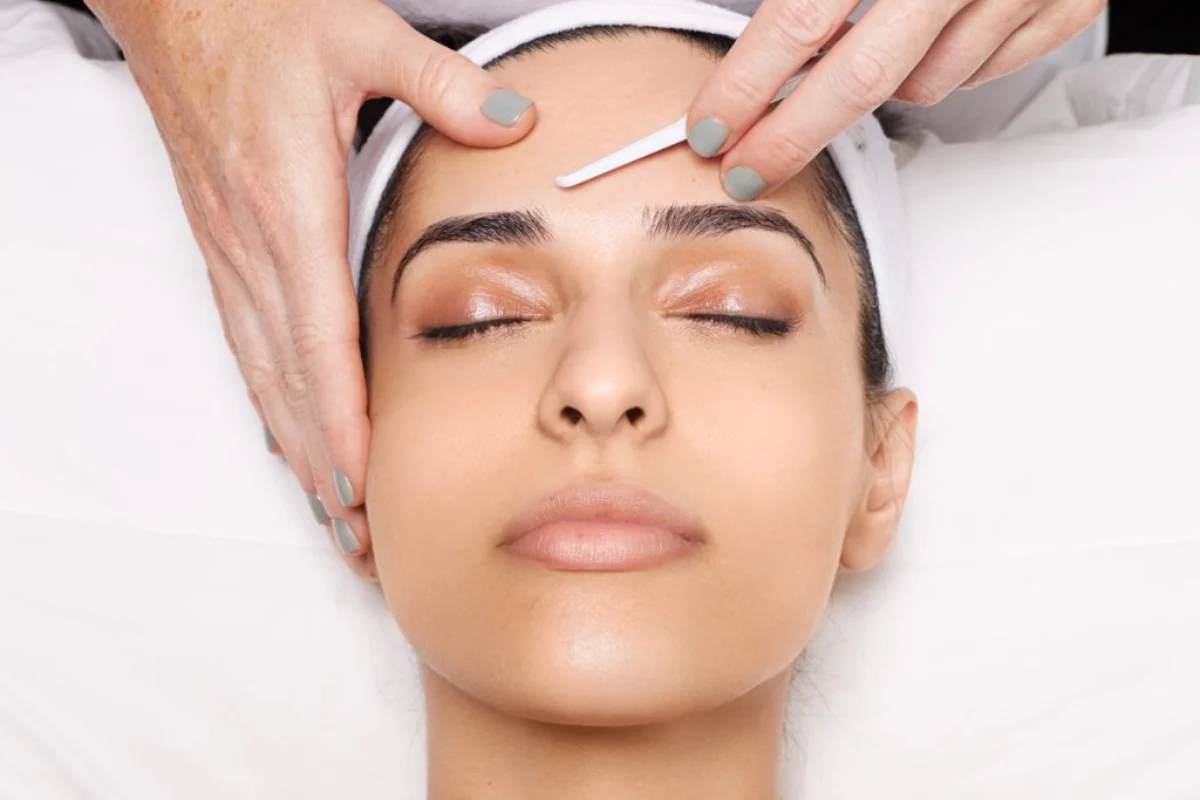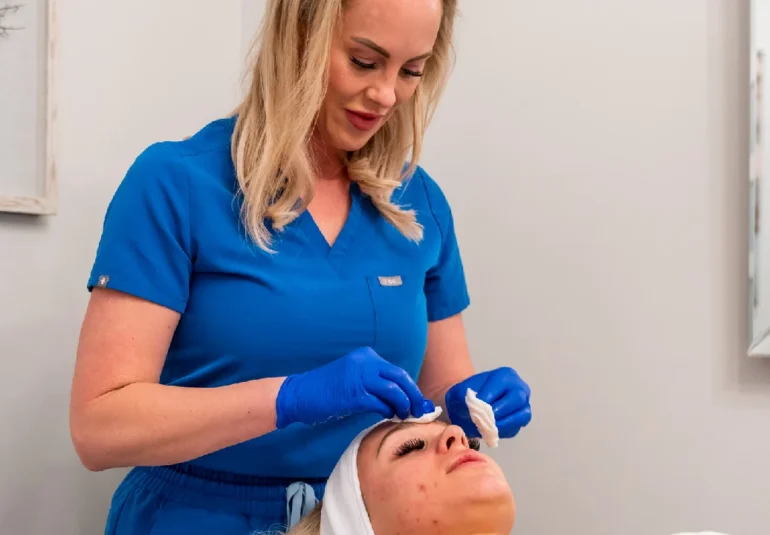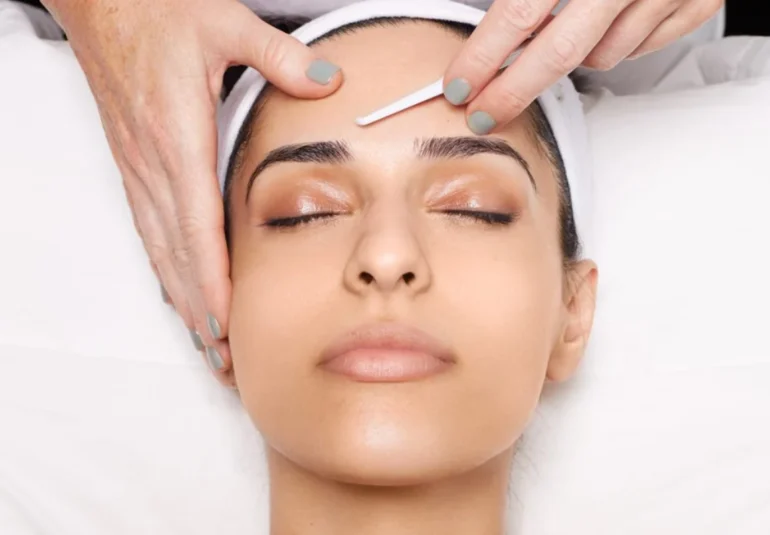

- Hydrafacial
-
by admin
Table of Contents
What is Dermaplaning?
Dermaplaning, a term that has become increasingly familiar in the lexicon of skincare enthusiasts, refers to a non-invasive exfoliating treatment that has taken the beauty world by storm. This technique is not your average skincare routine; it involves a trained esthetician who skillfully uses a surgical scalpel to gently scrape the skin’s surface. The primary goal? To meticulously remove dead skin cells and vellus hair, commonly known as peach fuzz. This process not only reveals a fresher, smoother skin surface but also paves the way for a more effective skincare regimen, as products can penetrate the skin more efficiently.
Brief History of Dermaplaning
To appreciate the essence of dermaplaning, one must delve into its historical roots. This practice can be traced back to the skincare rituals of the past, where various forms of physical exfoliation were employed to achieve a clearer and smoother skin complexion. Over time, what started as a basic shaving practice has metamorphosed into a sophisticated cosmetic procedure. Today, dermaplaning stands tall in modern beauty circles, celebrated for its simplicity and effectiveness. It’s a nod to the timeless pursuit of beauty, blending ancient practices with contemporary techniques.
Understanding the Basics
Definition and Purpose
At its core, dermaplaning is a mechanical exfoliation method. Unlike chemical exfoliants that work by dissolving dead skin cells, dermaplaning physically removes these cells along with fine facial hair. The purpose of this treatment extends beyond mere exfoliation; it is a rejuvenation process. By clearing away the outermost layers of the skin, it reveals a smoother, more radiant complexion beneath. This not only enhances the skin’s appearance but also contributes to its health, allowing it to breathe and regenerate more effectively.
How Dermaplaning Differs from Shaving
While dermaplaning might superficially resemble the traditional act of shaving, the differences are substantial. Regular shaving, typically aimed at hair removal, often uses standard razors and is usually done without the precision that dermaplaning requires. On the other hand, it is performed using a specific type of surgical scalpel and a technique that requires training and expertise. The scalpel is held at a precise angle and gently glided over the skin, ensuring that the exfoliation is even and safe. This method focuses on removing dead skin cells and fine hairs without the aggressive scraping or cutting that can occur with regular shaving. The result is not just about hair removal; it’s a comprehensive skin enhancement that regular shaving cannot achieve
The Dermaplaning Procedure
Step-by-Step Process
The procedure is a meticulous and refined process that begins with the fundamental step of cleansing the skin. This initial stage is crucial as it prepares the skin by removing any surface oils, dirt, or makeup, ensuring a clean canvas for the treatment. Following this, the core of the procedure unfolds.
A trained professional, armed with a specialized sterile blade, begins the delicate task of gliding the blade across the skin. This is done at a precise 45-degree angle, a critical aspect of the technique that allows for effective exfoliation without undue abrasion. The blade gently scrapes away the outermost layers of dead skin cells, along with fine vellus hair. This process is carried out with great care and precision, ensuring uniformity in exfoliation and minimizing any risk of irritation or injury.
Tools and Equipment Used
The tools used in dermaplaning are specialized and distinct from your average razors. The blades are specifically designed for it, typically a 10-gauge scalpel, which allows for a high degree of precision and control. These blades are attached to a handle that is ergonomically designed to provide the esthetician with the right balance and grip for the procedure. The use of such specialized equipment is pivotal in ensuring not only the effectiveness of the treatment but also the safety and comfort of the client.
Benefits of Dermaplaning
Enhanced Skin Texture
One of the most immediate and noticeable benefits following a dermaplaning session is the enhancement in skin texture. Clients often report a significant improvement, describing their skin as smoother, more vibrant, and rejuvenated. This improvement is attributed to the removal of the outer layer of dead skin cells, revealing a fresher, more youthful skin surface.
Improved Absorption of Skincare Products
Another significant benefit of this is the improved absorption of skincare products. By removing the superficial layer of dead skin, the barrier that impedes product penetration is also removed. This allows for skincare products to penetrate deeper into the skin, making them more effective and providing better results.
Reduction in Fine Lines and Wrinkles
Regular sessions can contribute to a reduction in the appearance of fine lines and wrinkles. This is achieved through the consistent removal of dead skin cells, which stimulates the regeneration of new skin cells, leading to a more youthful and plump appearance of the skin over time.
Ideal Candidates for Dermaplaning
Skin Types Suitable for Dermaplaning
It is a versatile treatment that is suitable for most skin types, especially those with dry or rough textures. It can be particularly beneficial for individuals looking to improve dull or dry skin, as it helps to reveal a brighter and smoother skin surface. However, it is always recommended to consult with a skincare professional to determine if it is suitable for your specific skin type and needs.
Who Should Avoid Dermaplaning
While dermaplaning is beneficial for many, it is not suitable for everyone. Individuals with active acne, highly sensitive skin, or certain skin conditions such as rosacea or keratosis pilaris should avoid this treatment. In these cases, it can potentially aggravate the skin condition, leading to irritation or worsening of symptoms. A professional consultation is crucial to assess whether it is an appropriate choice for your skin.
Pre-Procedure Considerations
Consultation with a Dermatologist
Before embarking on the journey, a pre-procedure consultation with a dermatologist is highly recommended. This step is crucial in assessing your skin’s condition and determining if dermaplaning is a suitable treatment for you. During this consultation, the dermatologist will evaluate various factors such as your skin type, any underlying skin conditions, your skin’s sensitivity levels, and your overall skin health. This assessment helps in identifying any potential risks and ensures that it will be beneficial and safe for your skin. It’s also an opportunity for you to discuss any concerns or questions you may have about the procedure.
Preparing Your Skin
Preparing your skin for dermaplaning is an essential step in the process. This preparation involves ensuring that your skin is clean and in its best condition. It’s important to avoid any harsh skincare treatments or products that could irritate the skin in the days leading up to the procedure. Additionally, ensuring that your skin is free of active infections, inflammations, or severe acne is vital, as these conditions can be exacerbated by the process.
The Role of a Professional Esthetician
Why Choose a Professional
Opting for a professional esthetician to perform dermaplaning is a decision that prioritizes both safety and efficacy. A professional brings a wealth of expertise and precision to the procedure, which is crucial for achieving the desired results without compromising skin health. They are trained in the correct techniques and know how to handle the tools properly, thereby minimizing the risk of cuts or irritation. Moreover, a professional can tailor the treatment to suit your specific skin needs, ensuring that you receive the most benefit from the procedure.
What to Expect During a Professional Session
During a professional session, you can expect a thorough and meticulous treatment. The esthetician will start with a skin analysis, followed by cleansing and then the actual process. Throughout the session, there is a strong emphasis on hygiene and precision. The environment is typically sterile, and the tools are sanitized to prevent any risk of infection. The procedure is usually painless and can be quite relaxing. Post-treatment, the esthetician will likely apply a soothing serum or moisturizer to calm the skin.
DIY Dermaplaning: Pros and Cons
How to Do It Yourself
DIY dermaplaning involves using a specific tool designed for home use and following a careful technique. It requires purchasing a suitable tool and learning the correct method of gently scraping the skin’s surface. The key is to maintain a light touch and use the tool at the correct angle.
Risks and Rewards
While DIY dermaplaning can be cost-effective and convenient, it carries certain risks. The primary concerns include the potential for skin irritation, uneven exfoliation, and the risk of nicks or cuts if not done correctly. The rewards, if done safely, include improved skin texture and the convenience of being able to perform the treatment at home.
Post-Procedure Care
Immediate Aftercare Tips
Aftercare following a dermaplaning session is vital for ensuring the best results and preventing any adverse reactions. It is advisable to avoid direct sunlight immediately after the procedure, as the skin is more susceptible to sun damage. Using gentle skincare products is recommended to avoid irritation. Additionally, it’s best to avoid wearing makeup for at least a day to allow the skin to breathe and recover.
Long-Term Skin Care Post-Dermaplaning
Long-term care after dermaplaning involves a commitment to regular moisturizing and sun protection. The skin can be more sensitive post-treatment, making it important to use a high SPF sunscreen to protect against UV damage. Adhering to a gentle skincare routine that includes hydrating and soothing products can help maintain the results of it and keep your skin healthy and radiant. Regular sessions, typically once a month, can help in maintaining the smooth texture and appearance of the skin.
Common Misconceptions About Dermaplaning
Debunking Myths
One of the most prevalent myths surrounding dermaplaning is the belief that the hair removed during the process will grow back thicker or darker. This misconception stems from a misunderstanding of how hair growth works. Scientifically, it does not alter the structure or growth cycle of hair follicles. The vellus hair (peach fuzz) that is removed during dermaplaning is fine and soft, and it grows back at the same thickness and color as before. The process of cutting the hair at the surface of the skin does not influence its natural characteristics.
Realities vs. Rumors
Understanding the realities of it is crucial for setting realistic expectations. This procedure is primarily an exfoliation method, not a hair removal solution. Its main benefits include smoother skin, improved skin texture, and enhanced efficacy of skincare products. It’s important for potential clients to understand that it is a skin treatment rather than a hair removal technique, and its primary goal is to rejuvenate and refresh the skin.
Comparing Dermaplaning with Other Exfoliation Techniques
Chemical Peels
Chemical peels are a form of exfoliation that involves applying a chemical solution to the skin, which causes the top layers to peel off. These peels vary in intensity, from superficial peels that target the outermost layer of skin to deep peels that reach deeper layers. The primary difference between chemical peels and dermaplaning lies in their approach: chemical peels chemically exfoliate the skin, while dermaplaning provides physical exfoliation. Chemical peels can be more intensive and may require a longer recovery time compared to dermaplaning.
Microdermabrasion
Microdermabrasion is another popular exfoliation technique that uses fine crystals and vacuum suction. This mechanical process is designed to exfoliate the skin and remove dead skin cells, similar to dermaplaning. However, microdermabrasion targets deeper layers of the skin and is often used to address issues like deep acne scars and more pronounced skin texture issues. In contrast, dermaplaning is gentler and more suited for surface-level exfoliation and hair removal.
The Impact of Dermaplaning on Acne-Prone Skin
Benefits and Cautions
For individuals with acne-prone skin, dermaplaning can be a double-edged sword. On the one hand, it can help in removing dead skin cells that can clog pores and exacerbate acne. On the other hand, if performed on skin with active acne breakouts, it can irritate the skin and potentially spread bacteria, leading to more breakouts. Therefore, it’s crucial for individuals with acne-prone skin to consult with a dermatologist or skincare professional before undergoing dermaplaning.
Expert Opinions
Dermatologists and skincare experts generally advise caution when it comes to dermaplaning for acne-prone skin. They may recommend waiting until active breakouts are under control before considering this treatment. Additionally, they can provide tailored advice and alternative treatments that might be more suitable for managing acne-prone skin while still achieving the benefits of exfoliation.
Cost and Accessibility
Average Cost of Professional Dermaplaning
The cost of professional dermaplaning can vary widely based on several factors, including geographic location and the level of expertise of the practitioner. Generally, the price range can be categorized as moderate to high. In metropolitan areas or high-end spas and clinics, the cost may be on the higher end due to the overhead expenses and the expertise of the practitioners. It’s important for potential clients to consider the value of the treatment in terms of the quality of service and results when evaluating the cost.
Finding a Qualified Practitioner
Locating a skilled and qualified professional for dermaplaning is a critical step in ensuring a safe and effective treatment. Researching and seeking referrals are excellent strategies. Potential clients should look for practitioners with specific training and experience in dermaplaning. Checking online reviews, asking for recommendations from friends or family, and consulting with dermatologists can also be helpful in finding a reputable professional.
Frequency of Dermaplaning Sessions
Recommended Schedule
The recommended frequency for dermaplaning sessions typically is once a month. However, this can vary based on individual skin types and conditions. Some may benefit from more frequent sessions, while others may require less frequent treatment. It’s important to follow the guidance of a skincare professional who can tailor the frequency to suit individual skin needs.
Overdoing It: The Risks
Overdoing dermaplaning can lead to adverse effects such as skin irritation and increased sensitivity. It’s crucial to adhere to the recommended frequency to avoid over-exfoliation, which can strip the skin of its natural oils and barrier, leading to more harm than good.
Combining Dermaplaning with Other Treatments
Synergistic Skincare Routines
Combining dermaplaning with other skincare treatments and products can enhance overall skin health. For instance, following up a dermaplaning session with a hydrating facial can provide additional moisture and nourishment to the freshly exfoliated skin.
What Works Well with Dermaplaning
Treatments and products that complement dermaplaning include hydrating serums, gentle exfoliants, and nourishing masks. These can help to soothe and hydrate the skin, maximizing the benefits of dermaplaning.
Safety and Hygiene Practices
Ensuring Sterilization and Cleanliness
Adhering to strict sterilization and cleanliness protocols is essential in dermaplaning to prevent infections and ensure a safe procedure. This includes using sterilized equipment and maintaining a clean and hygienic environment.
Avoiding Cross-Contamination
Using disposable blades and ensuring a sterile environment are key practices in avoiding cross-contamination. This is crucial for the safety and health of the client and the integrity of the treatment.
The Psychological Impact of Dermaplaning
Boosting Self-Esteem and Confidence
Many clients report a significant boost in self-esteem and confidence following a dermaplaning session. The immediate improvement in skin texture and appearance can have a positive impact on how individuals feel about themselves.
Personal Stories and Testimonials
Testimonials from individuals who have undergone dermaplaning can offer valuable insights into the personal impact of the procedure. These stories often highlight the transformative nature of the treatment, both in terms of physical and psychological benefits.
Future Trends in Dermaplaning
Innovations and New Techniques
The field of dermaplaning is continually evolving, with new techniques and tools emerging. These advancements aim to enhance the efficacy, safety, and comfort of the procedure.
Predictions from Skincare Experts
Experts in the skincare industry predict a continued rise in the popularity of dermaplaning. This is attributed to its effectiveness, the growing demand for non-invasive skincare treatments, and ongoing innovations in the field. The future of this looks promising, with potential advancements that could make the treatment even more accessible and effective.
FAQs About Dermaplaning
Addressing Common Questions
This section is dedicated to addressing some of the most frequently asked questions about dermaplaning. These questions range from concerns about the procedure to queries about aftercare and benefits. Providing clear and concise answers to these questions can help demystify the process and educate potential clients about what to expect.
Expert Answers
The responses in this section come from skincare experts, including dermatologists and experienced estheticians. Their insights offer authoritative and reliable information, ensuring that readers receive accurate and professional advice. These expert opinions are crucial in helping individuals make informed decisions about whether dermaplaning is right for them.
Conclusion
Summarizing the Benefits
In conclusion, dermaplaning is a multifaceted skincare treatment that offers numerous benefits. It excels in improving skin texture, enhancing the skin’s radiance, and promoting a more youthful appearance. By removing dead skin cells and fine facial hair, it not only improves the skin’s appearance but also enhances the efficacy of skincare products. The procedure is relatively quick, non-invasive, and can be tailored to suit different skin types and concerns.
Final Thoughts on Dermaplaning
As we conclude this comprehensive guide, it’s important to offer a balanced view . While the advantages are significant, it is also crucial for individuals to consider the precautions associated with the procedure. Consulting with a professional, understanding one’s skin type, and following proper aftercare are essential steps in ensuring a positive and safe dermaplaning experience. When done correctly and under the right circumstances, can be a valuable addition to one’s skincare regimen, offering a unique way to rejuvenate and maintain healthy, glowing skin.



